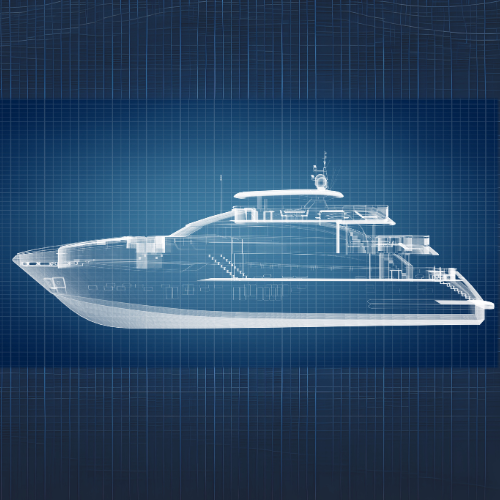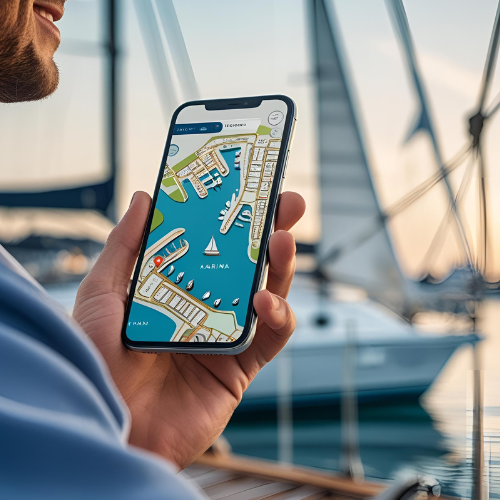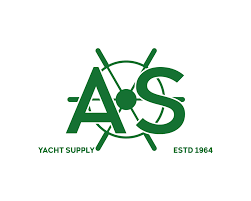By Rebecca Whitlocke
The use of artificial intelligence (AI) is transforming industries globally, and the yachting sector is no exception. From yacht design to crew ops, AI is stepping into our job and daily life. AI is being used to improve operational efficiency, support customer interactions, and fuel content creation.
But with new tools comes new questions. Who owns AI-made content? What does “smart” mean at sea? And how do we keep trust and ethics on track when we push out AI-created marketing in the yachting industry?
Below, I look at five real-world AI use cases in the yachting industry, some potential pitfalls to be aware of, free AI course recommendations, and how to create AI guidelines for your yachting business.

Photo: C. Ciocorlan
1. AI-Driven Yacht Design
The days of relying solely on a hand-drawn sketch to develop a yacht concept are long gone. AI now assists designers in mapping ambitious concepts, testing hull form, and fine-tuning layouts – all before a single render is sent to the client.
Key points:
- Faster conceptualisation: AI systems analyse physics, shape, and function in minutes rather than months. That means a faster shift from idea spark through to spec.
- Data-led layouts: Builders and designers can now test how guests move through spaces, where crew and guest bottlenecks form, or how furnishings or furniture sit on deck – all in pre-build AI simulations.

AI has numerous use cases for the yachting sector including yacht design
2. Charter & Guest Systems
AI helps in anticipating VIP preferences before they are expressed, from custom menus to onboard itineraries. Yachts can prepare for hyper-individualised service, by monitoring guest preferences such as using AI-powered charter itinerary builders like Guest Trip, or even keeping an eye on in-system guest profiles.
Key points:
- Customised charters: AI matches guests’ choices for meals, spa treatments, or yacht toys based on patterns or past charters.
- Crew support: From wine selections to room temperature options, interior crew and yacht chefs have an advantage, allowing them to remain ahead of the game with ease and reduce misunderstandings.
3. Predictive Maintenance, Diagnostics & Security
Yacht downtime affects customer trust, crew morale, and charters when it comes to yacht fleet maintenance. AI systems are now using sensor data and machine learning models to identify issues before they need to be fixed.
Key points:
- Live insights: Before alarms sound, AI systems alert captains, bridge officers, and engineers to maintenance updates, risks, system strain, or wear by tracking engine data, bilge levels, or nearby objects or boats.
- Smarter logs: Captains can examine AI-sorted logs that highlight actual red flags rather than sifting through reports.
4. AI in Refit Planning & Yard Workflows
Refits may spiral out of scope. Even though every yacht build is unique, some shipyards and managers are already using AI to monitor progress, identify issues, and map costs in real-time, which helps projects stay on schedule and budget.
Be cautious that AI can miss one-off issues that only a seasoned project lead will notice. Tools must support, not replace, the eye of experience.
Key points:
- Timeline checks: Project and technical managers can avoid shipyard setbacks by using AI to map out phases that might overlap or cause delays.
- Budget tools: AI can identify when a task appears underquoted or a part is priced incorrectly by using predictions and data from previous builds.
5. AI for Yacht Crew Operations
AI is beginning to change the way some crew agencies recruit crews by sifting through piles of CVs and identifying the best crew fit based on factual information rather than conjecture. Even if adoption is still in its early stages, it’s a change worth noting.
Key points:
- High-volume CV parsing: AI tools can help extract skills, certifications, language competency, and yachting experience from resumes and job applications at speed. This allows crew recruiters to concentrate on higher-potential matches and better placements. To assist equitable, skill-based hiring, certain algorithms now detect bias in job postings or shortlisting candidates.
- Compliance: In an industry where compliance and safety matter, AI can be used for operational demands and crew rostering that complies with work/rest regulations.

AI is used to improve efficiency and operational processes in the yachting industry
The Challenges, Risks and Ethical Considerations for AI in Yachting
A number of issues are brought up by AI’s increasing integration into the superyacht industry, including the need to prioritise accountability, ethics, transparency, data privacy and security, and overcoming bias. The task isn’t getting any easier given how quickly generative AI is evolving every day.
For instance, AI is being used more and more to create marketing content for the yachting sector, such as photographs, videos, social media captions, newsletter communications, and website copy.
I’m willing to say that most yachting companies don’t even have an asset management process in place that addresses clearance and credits, comprehensively documents staff training on AI systems, or identifies the source of visual assets that could be used in a generative AI activation in the future.
Some considerations and questions remain:
- Who owns an exterior or interior yacht design concept that was inspired by a prompt rather than a pencil? Naval architects and designers must tread carefully around rights, copyright, and IP laws still catching up to the tech.
- How can maritime companies harmonise AI-led automation, service needs, and providing crew and employees with rewarding work opportunities?
- Where does the line for “due diligence” start and end when AI software and systems filter resumes and help make decisions on the crew hire?
- AI has great promise for automating onboard duties or maintenance tasks while adhering to maritime laws. However, in order to save money or time, we must make sure AI doesn’t ignore hazards. Did you know that marine equipment is categorised as ‘High-risk AI systems’ according to the EU AI Act which means it’s subject to intense diligence, record keeping and risk assessment? This includes AI-systems for personal watercraft, lifts, radio equipment, personal protective equipment and more. Based on this, does the yachting industry have procedures in place for outlining the duties and responsibilities of the various parties involved in the development and management of AI-based systems and putting safety precautions in place to reduce the possibility of mishaps or malfunctions? When an AI-powered system for navigation or monitoring gaseous fuels makes an incorrect call, who is at fault?
- How dependable are AI systems in emergency scenarios like medical situations onboard or mechanical breakdowns? Yachting firms need to be aware of accountability, testing and real-world scenarios.
Copyright & Intellectual Property: AI Considerations
Copyright and intellectual property issues may arise as AI mimics or learns from human-created content or ideas. Who owns the results or outcomes created by AI? Yachting companies are in a unique position to embrace AI responsibly while ensuring compliance with regulations such as the EU AI Act, however there are many grey areas.
On February 2nd the first rules from the EU AI Act came into force. Under EU copyright law, only works that show “human intellectual creation” can be protected. Courts and policymakers have made it clear that AI, on its own, does not count as an author. If humans play a meaningful role in shaping the output, they may be able to claim copyright. The EU Copyright Directive (2019/790) reinforces this principle, requiring a work to reflect the author’s personality and free, creative choices.
On January 29, the US Copyright Office issued a report on the copyrightability of works consisting of or incorporating material generated by artificial intelligence systems. If a work is entirely AI-generated, it’s not eligible for copyright.
In a move aimed at combating AI-generated deepfakes, Denmark is set to become the first European country to amend copyright laws to grant individuals copyright over their own face, voice, and physical likeness. Unauthorised use of a person’s likeness in AI-generated videos, fake endorsements, or branded content has the potential to damage reputations, mislead consumers, and undermine trust. The law says AI providers must label AI-generated content on their platforms by putting watermarks on the videos, and to disclose which training sets are being used to develop their models. If an AI company is found in breach of transparency rules, it could face colossal fines – potentially up to €35 million or 7% of global turnover for banned practices. I cringed when yachting companies repurposed the Astronomer CEO and HR Director’s Coldplay concert mishap into yachting-themed memes and AI-powered videos – this type of content will be monitored closely in the future. Creators, influencers and marketing teams take notes!

AI is transforming the superyacht industry with applications in design, operational processes, predictive maintenance and communication
Recently, WeTransfer – a platform used by many PR agencies in the yachting sector – ruffled a few feathers lately when their revised terms caused confusion. A provision that gave WeTransfer broad rights over user-uploaded content was concealed in the legal fine print. This change went unnoticed by the majority of WeTransfer users until writers, graphic designers, PR agencies and filmmakers vented their outrage on social media that their work – which is frequently confidential, proprietary, or unreleased – could now be used without their permission or payment. The terms included the ability to host or display files as well as reproduce, alter, commercialise, and even use them to train machine learning models. Within a few days, WeTransfer took a step back and made it clear that it neither sells nor shares content with outside parties, nor does it utilise user data to train AI or machine learning models.
AI-generated content is not necessarily subject to fair use laws. Yachting companies may still be subject to legal repercussions if they imitate copyrighted products. Unfortunately, on social media we can see daily examples of copyright and plagiarism breaches in the yachting industry – this is even without AI being thrown into the mix. To prevent possible copyright infringement, it is essential to make sure AI-generated material is unique and reflects a brand’s tone of voice and creative choices.
In a nutshell, copyright safeguards creative works in tangible form, such as books, podcasts, software, and videos. Concepts and ideas cannot be protected, but the manner in which they are expressed can. Brand identification, or how to identify the source of something like a logo, phrase, or words that help customers in recognising a particular business or product they offer, is the main emphasis of trademarks.
I’ll use yachting podcasts as an example because it’s a growing media: The contents of a yachting podcast are copyrightable, but the logo that identifies to their audience that it’s part of a podcast channel is subject to a trademark. Podcast creators should also always have guests and hosts on their show sign podcast guest release forms. It’s very important to get releases from hosts and guests so that you have the right to use their likeness, name, photo or voice in distributing, promoting or syndicating the episodes they’re in.
Licensing and Permissions for AI-Generated Content
Maritime companies are using AI tools for advertising and research purposes to identify and monitor trends, and market opportunities.
However, caution should be taken to ensure users are aware that AI platforms have licensing agreements that dictate how generated content can be used – similar to how yachting companies already use stock photos. AI platforms have licensing agreements that specify how created content can be used. While some systems give the platform partial rights, others let users keep ownership. If the AI tool was trained on copyrighted data, third-party restrictions might also be applicable. It’s also crucial to remember that many AI systems are trained on massive text databases, such as Wikipedia or Reddit, which may contain restricted content.
Yachting firms should verify sources, examine terms for licensed content, and take into account differences in copyright laws and usage rights when marketing internationally.
Data security and privacy
Numerous yachting websites and systems collect personal data, including preferences, job titles, and email addresses. Businesses must implement strict data governance and cyber security protocols and comply with data protection laws like the GDPR in order to ensure privacy and security.
Transparency
Employees and customers should be informed about the use of their customer profiles and data. A yachting company using AI to suggest services or for targeted advertising are two examples. Openness and transparency contributes to increased trust and confidence in AI systems.

Data privacy and security is paramount when working with the yachting industry
Bias and Fairness
There are already disparities in diversity and inclusion in the yachting industry with regard to marketing materials, speaker panels at yachting events, and imagery on yachting websites. We have to make sure that AI-powered interactions don’t maintain or even worsen already-existing biases and inequalities in yachting.

Yachting companies must take steps to overcome bias with AI systems
AI-powered dynamic pricing or recommendations can adjust charter rates based on demand, seasonality, and customer demographics. Yachting companies should ensure that their brokerage pricing policies are transparent and fair to customers in various geographic areas, and don’t unintentionally favour specific companies or demographics.
We must control expectations regarding communication and advertising as AI technologies and platforms will probably incorporate in-platform advertising.
Understanding AI Ethics: Best Practices for Yachting Companies
As AI continues to embed into the yachting industry, adopting a responsible AI framework is a legal obligation, morally correct and a competitive advantage. By establishing clear guidelines, ensuring data privacy, and maintaining human oversight, yachting companies can use AI responsibly and ensure regulatory compliance.
Here is a four-step framework for yachting companies to implement AI responsibly:
1. Establish Accountability, Ethical Guidelines & Ownership
Create policies and contracts covering accountability, fairness and transparency. Form a committee and consult with AI developers and legal experts. This should not be a tick-box exercise; integrate these principles into your company culture and operations. Yachting companies need to document clear records of how human decisions, editing, or curation lead to the final output because this is vital in establishing authorship.
Content producers and marketing teams in particular need to sit up and pay attention. Contracts and terms should be updated to account for AI systems for providers, deployers, importers and distributors, particularly in agreements pertaining to tech supply, AI-powered guest services, or refit. The ownership of any AI-produced content should be specified in contracts. Human cultural sensitivity, conceptual understanding, and strategic thinking should be integrated with AI techniques. Clear ownership terms that outline who owns the AI content – the business, the employee, or another party – should be included by businesses.
AI systems need to be updated, monitored, and audited. Make sure AI-generated text, images, pricing, and videos don’t violate anyone else’s intellectual property and current AI and IP rules are followed.
2. Ensure Data Privacy & Security
Yachting companies should establish strong data governance and cybersecurity practices to protect customer’s data and individual privacy whilst complying with data consent and regulations like GDPR.
3. Always Keep Human Oversight
Flag states and insurance firms are still working through where AI fits in maritime rules. Superyacht companies should confront prejudice, and offer practical advice and recommendations within their content creation that their clients won’t find elsewhere.
Yachting businesses must continue to be accountable for their work, which includes verifying the accuracy of their sources and making sure there is no plagiarism. Public awareness initiatives that teach yachting professionals how to spot and steer clear of false information are necessary to combat deepfakes and misinformation. Media authentication techniques like watermarks and signature analysis, which can assist in confirming the legitimacy of media content, offer an additional remedy.
People and brands can better defend themselves against the negative impacts of deepfakes and false information by being informed and vigilant.

Yachting companies must fact-check sources to protect their reputation
4. Prioritise AI Training & Education
“AI will not replace you or your business. A person or business assisted by AI will.” – Piers Linney
I think this comment hits the nail on the head! There’s a growing demand for yachting professionals who have AI skills and can use it for commercial and support roles. Yachting companies can integrate AI to raise their game with operational efficiency and agility by automating many routine tasks and reducing manual input for complex tasks. It is particularly useful when structuring or summarising huge data sets.
Some tips:
- Read the terms for AI platforms, tools, and apps. AI clauses are growing more prevalent and ambiguous. You should incorporate risk evaluations and legal reviews into your procurement procedure.
- According to Article 4 of the EU AI Act, you should take measures to guarantee that your employees have a sufficient level of AI literacy, taking into account their technical expertise, experience, education, and training as well as the environment in which the AI systems will be utilised. I have included links to three useful resources at the bottom of this blog: “FAQs about AI Literacy”, the “General-Purpose AI Code of Practice” and the “Living repository to foster learning and exchange on AI literacy.”
- Make sure your marketing staff are knowledgeable about the implications associated with intellectual property, data protection, and AI ethics.
- Use solutions that let you retain complete rights to the work, or make sure the AI platforms and tools you use for marketing and content production include clear, commercial-use permissions for the output. This could include creating incredibly thorough prompts that do much more than only offer ideas or suggestions. You must be able to demonstrate that you had a specific idea or concept in mind and that you just employed AI as a tool to help create it. The prompt “A yacht on a smooth sea” is not detailed enough. However, “A white superyacht with three decks cruising on a calm turquoise sea with soft dusky light highlighting Positano’s terraced colourful buildings in the background” is more descriptive and shows human creative suggestions.
- If you don’t have in-house AI knowledge, find a trusted partner who does.

Superyacht companies should maintain human oversight in tandem with AI decision-making or outcomes
Looking for free AI courses for beginners? Here are 8 introductory AI training resources :
- Two different courses on AWS Skill Builder: “Introduction to Responsible AI” and “Responsible Artificial Intelligence Practices” : https://skillbuilder.aws/search?searchText=introduction-to-responsible-ai&showRedirectNotFoundBanner=true
- Career Essentials in Generative AI by Microsoft and LinkedIn: https://www.linkedin.com/learning/paths/career-essentials-in-generative-ai-by-microsoft-and-linkedin
- DeepLearning AI with Andrew Ng on Coursera: “AI for Everyone”: https://www.coursera.org/learn/ai-for-everyone?
- Google Cloud Skills Boost: “Introduction to Responsible AI”: https://www.cloudskillsboost.google/course_templates/554
- IBM “AI Foundations for Everyone” on Coursera: https://www.coursera.org/specializations/ai-foundations-for-everyone
- LinkedIn AI ethics mini course: https://www.linkedin.com/learning/ethics-in-the-age-of-generative-ai/generative-ai-and-ethics-the-urgency-of-now
- Microsoft Learn’s “Embrace responsible AI principles & practices”: https://learn.microsoft.com/en-us/training/modules/embrace-responsible-ai-principles-practices/
- BONUS: For AI training resources (both free and paid options) available for compliance with Article 4 of the EU AI Act, refer to these resources: https://artificialintelligenceact.eu/ai-literacy-programs/ and https://digital-skills-jobs.europa.eu/en/learning-content?
Thank you to Our Faceless Crew for inviting me to share my insight regarding the impact of AI ethics for yachting companies, you can read the article here: https://ourfacelesscrew.com/blogs/news/understanding-ai-ethics-a-framework-for-yachting-companies
Summary
Yachting companies should start by looking at their current AI policies and protocols to make sure they comply with ethical standards and regulatory requirements, as well as putting responsible AI use into practice and providing training. By doing this, you’ll establish your maritime business as a leader for responsible AI, win over stakeholders and build trust with customers while guaranteeing adherence to changing international laws.
This article is not an in-depth overview or legal advice, and in all cases yachting companies should seek professional legal advice and follow national regulations at a minimum. However I hope you have formulated some questions and it has prompted superyacht companies to think about how AI is integrated and monitored inside their day-to-day business and the wider societal implications that go beyond legal compliance.
This blog has taken me over 10 hours to research, write and edit, so if you found this blog informative or useful, please share it. You can follow Antibes Yachting on social media to stay updated with future articles.
Sources:
- Deck TV on YouTube: How AI is shaping the future of yacht building: https://youtu.be/HZJJjMUHwuc?si=j4MZZxTE3X-FoPYt
- EU Artificial Intelligence Act: https://artificialintelligenceact.eu/
- European Commission FAQs about AI Literacy: https://digital-strategy.ec.europa.eu/en/faqs/ai-literacy-questions-answers
- EU General Purpose AI Code of Practice: https://digital-strategy.ec.europa.eu/en/policies/contents-code-gpai
- EU Living repository to foster learning and exchange on AI literacy: https://digital-strategy.ec.europa.eu/en/library/living-repository-foster-learning-and-exchange-ai-literacy
- Copyright Registration Guidance: Works Containing Material Generated by Artificial Intelligence, 88 Fed. Reg. 16,190 (Mar. 16, 2023)
- Euronews – Denmark Copyright against Deepfakes: https://www.euronews.com/next/2025/06/30/denmark-fights-back-against-deepfakes-with-copyright-protection-what-other-laws-exist-in-e
- ISO/IEC 42001:2023
- McKinsey: The Economic Report of Generative AI (June 2023)
- Megayacht News: https://megayachtnews.com/2025/06/the-ai-dilemma-the-yacht-law-podcast/
- Superyacht Times: How AI is transforming the yachting industry: https://www.superyachttimes.com/yacht-news/how-ai-transforms-superyacht-industry
- The 2021 Coordinated Plan on Artificial Intelligence
- U.S. Copyright Office, Copyright and Artificial Intelligence Part 1: Digital Replicas (July 2024)
- U.S. Copyright Office, Copyright and Artificial Intelligence, Part 2: Copyrightability (January 2025)
- Yahoo WeTransfer’s AI and LLM terms of service: https://tech.yahoo.com/ai/articles/wetransfers-confusing-terms-clause-prompts-023000765.html?guccounter=1&guce_referrer=aHR0cHM6Ly93d3cuZ29vZ2xlLmNvbS8&guce_referrer_sig=AQAAAHlDXoAj_xFvF8WIhxH_Fzv1uxrNg9N2cC_rZIJbx8VEWOUqz_laDBTWTjLff-l37WvdWBv0KopZFP6DQOj1eWvcGhtAL1bPs92FmuJplz1wHQgMJ0sjbrFiM_kE-8-7CbA_ieibTJXKFHBb_6ostMprWPvgcbMnZUI-X-pfXJ7M




